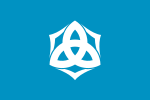Triqueta

The Triqueta , also called Triquetta or Triquetra , consists of three connected circular arcs. The name comes from Latin and means triangular or knot of threesome or simply triangle .
Appearance
A geometric figure with three corners is shown in the form of an equilateral triangle with round arcs. In this figure, round triangles are created inside. This triangle also includes the aspects that are said to be associated with the number three . It is optionally occupied by a circle.
origin
The triqueta can be found in Indian art 5000 years ago. Due to the proximity of the Celtic and Germanic cultures, an origin from one of the two cannot be clearly deduced. From the Celtic world z. B. on Celtic crosses the female symbol changes to a male symbol in Christianity z. B. in Gothic art.
Usage and symbolism
- In Christian iconography , the triqueta means the trinity (or trinity, trinity , Latin: trinitas ), i.e. the unity of God the Father, God the Son and the Holy Spirit . It symbolizes eternity.
- The Norwegian King Harald Hardråde (king from 1047 to 1066) used it on his coins.
- In addition, the symbol is on the book of shadows from the Charmed series .
- In addition, John Paul Jones , Led Zeppelin bassist , used the Triquetra as his symbol.
- In Wicca she is a symbol of the triune goddess (virgin, mother, old lady).
- In the Netflix series Dark , the triqueta symbolizes the interweaving of the three time levels in which the story takes place.
- The band POD uses the symbol on some CD covers .
See also
Web links
- Article Triqueta in the Heraldry Wiki
- Dreischenkel Kunstlexikon, PW Hartmann (accessed September 7, 2019)



